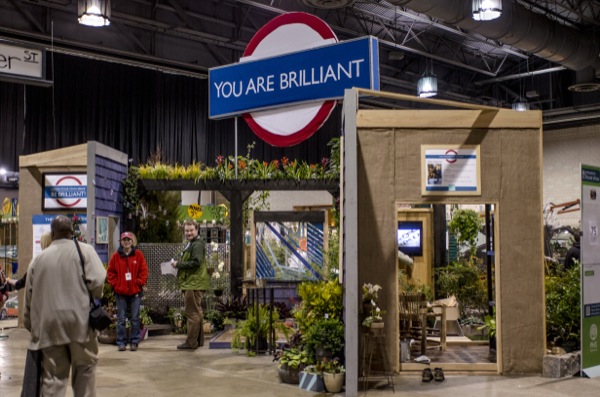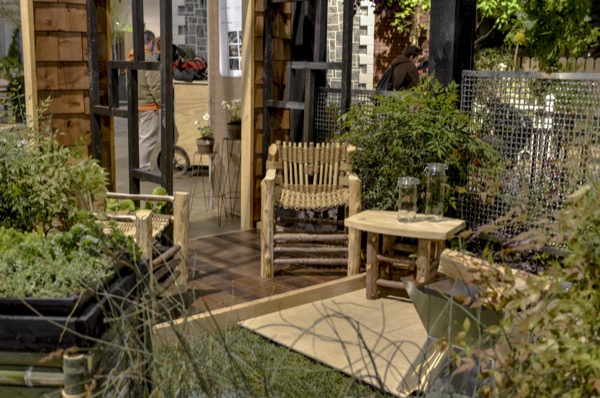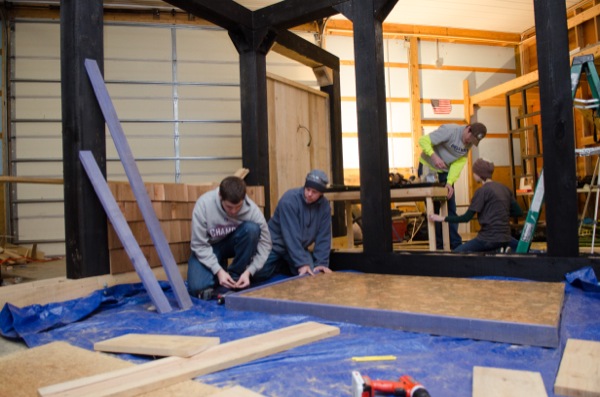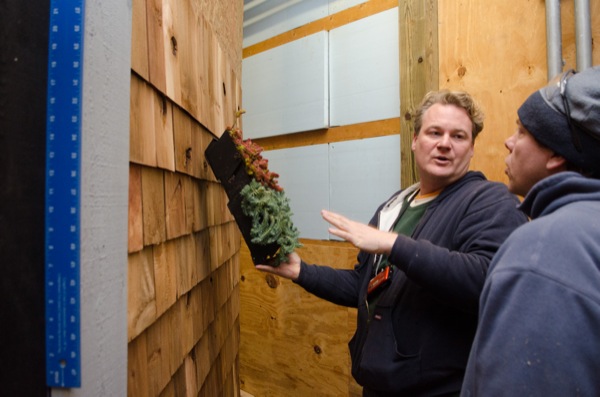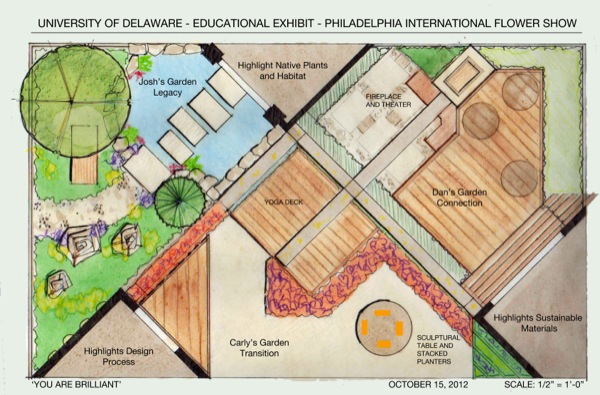Brilliant design
UD students, professors create display for Philadelphia Flower Show
9:22 a.m., March 5, 2013--“You are brilliant and you can design your own garden.” That is the message that professors and students from the University of Delaware want observers to take away from looking at their display, which is on view and received a “Special Achievement” award at the 2013 Philadelphia Flower Show.
“We’re going to teach people how they can design their own back yard space because we’re all brilliant,” said Jon Cox, assistant professor in UD’s Department of Art. “They just have to figure out what their interests are and how they can design their space for their needs.”
Campus Stories
From graduates, faculty
Doctoral hooding
Cox is teaching a class -- with Jules Bruck, associate professor in the Department of Plant and Soil Sciences, and Anthony Middlebrooks, associate professor in the School of Public Policy and Administration -- that has worked on the UD display.
This year’s Philadelphia Flower Show, which runs from March 2-10 at the Pennsylvania Convention Center, has a British theme titled “Brilliant.”
Led by the professors, an interdisciplinary group of 17 UD students in plant science, leadership and art have been working on the University’s project, designed to tie in to the overall theme and titled “You Are Brilliant.”
The class is aimed at teaching the students about the design process and showing them how to work together to design a garden suited to a client’s needs.
However, the overall project began last summer and has required students to engages and tackle various facets of the project. “The leadership major emphasizes creativity, innovative problem-solving and collaboration,” Middlebrooks said. “This project offers students so many opportunities to build their creativity and develop their leadership.”
“I think the biggest take away for all of us is how collaborative landscape design is,” said Bruck. “Most of the time, landscape designers work in a vacuum -- ‘I’m the creative genius and I’m going to sit at my drafting table and it’s going to be my endeavor with input from the client.’ But this is like what happens when you get lots of people from lots of different majors, backgrounds, interests and experiences working together on a design challenge. It just ramps everything up. Everything gets better, more creative and more interesting.”
One of the students who is helping out the class is Emma Brown, a freshman majoring in landscape horticulture and design. Brown said that the process has been incredible, as helping out with a project for the Philadelphia Flower Show has been something that she has wanted to do for a while.
“I’ve been to the flower show before and when I came here, it wasn’t one of the things mentioned right off the bat but somewhere along the line someone mentioned the class and I thought that would be a really, really cool thing to do,” she said.
While she is not officially a member of the class, Brown said she has enjoyed watching the class work and the interaction between the professors and students.
“The professors allowed the students to design elements of the show and I thought that was spectacular,” Brown said. “I know I’m not at that level yet but the higher level students in horticulture and landscape design – and even people who aren’t in our major but are interested in doing this – have been able to utilize these skills, put them to the test and really accomplish something immense and incredibly beautiful. The finished result will be spectacular, I know it.”
The clients
Using three clients, the goal of the project was to build three different gardens based on the clients’ individual personalities. The result was three very different gardens.
The first one is titled “Connector” and was made for Dan Walsh, who lives in Wilmington and works as a banker. The name comes from the fact that Walsh is politically connected and does a lot for the community, including running a not-for-profit organization called Mustaches for Kidds, in which people grow mustaches during the month of November for the Supporting Kidds center for grieving children and their families.
Cox explained that as a bachelor, Walsh “doesn’t want to do a lot of plant maintenance, so his garden is very low maintenance. But he has an outdoor theatre, and he has an outdoor fireplace, so it still features a lot of things that a bachelor would want in his particular garden.”
The space is also equipped with a doghouse for Walsh’s brown Labrador retriever named Willie.
The second space is titled “Transitional,” as it is designed for 24-year-old Carly Burrus, a UD graduate who is a young artist. The idea behind the garden is that since Burrus is in a transitional part of her life and not really sure where she will be a year from now, everything in the garden is easily transportable.
Bruck said the garden is “very artsy, very much showing off her personality and the youngness of being a 20 something-year-old artist.”
Cox added that the space has a yoga mat made out of corkboard and lots of easily moveable planting containers. “We know a 24-year-old probably isn’t going to be in the same space for a very long time so everything she can just pack up and take with her to the next spot,” he said.
The last space is called “Legacy” and is designed for Josh Taylor, a naturalist and photographer who teaches photography workshops in the Mid-Atlantic region. The idea behind this garden, according to Bruck, is “if this was your last garden and you were going to leave a legacy what would you put in your garden?”
Because of it’s “Legacy” inspiration, this garden has one big tree that will be around for future generations, shrubs, a pond with a waterfall and lots of native plants to allow Taylor to relax and watch birds in his garden.
“Josh’s garden uses a lot of native materials and we’re hoping to show the design process -- how the students designed all these gardens and how they picked out the things, and that observers can do this, too. There will be design process pieces, and take-aways that you can take with you so you can understand how to do this on your own,” said Bruck.
Cox added, “All of our elements are also highlighting sustainable processes so we’ve got recycled materials, and we have things that you can use over again.” He singled out the yoga mat made of materials from a cork tree as an example of sustainability.
The actual flowers for the show have been grown in University of Delaware greenhouses by Taylor Fehmel, a senior in the College of Agriculture and Natural Resources, who has worked with the flowers as an independent study project since fall 2012.
Bruck said that Fehmel has been “forcing” the flowers, or getting them to grow early. It is a complex project and Bruck said of Fehmel, “She’s been cool under fire, because this has been a trial by fire.”
Bruck added, “It’s funny, we spend so much time on the construction of the exhibit but there’s only so many people who can be in there working on the plants. You can’t just sit there watching the things grow, but it’s the most important part, and the Philadelphia Horticulture Society (PHS) is always quick to remind us that it’s a flower show and, as cool as your exhibit might be, you need to have a lot of greenery and a lot of flowers. She’s been working hard on that.”
Bruck was also quick to point out that the show would not have been possible had it not been for the contributions from various donors. PHS donated funds to support the project, as did Shift Design in Philadelphia. The team also received a generous Scholarship of Engagement grant through Lynnette Overby, director of UD’s Office of Undergraduate Research and Experiential Learning, she said.
Once the flower show is over, the exhibit will not be gone. Bruck explained the class will transport the exhibit to a local park in Wilmington where it will be on display and serve to beautify that section of the city.
“We’re then going to take the pieces and the plants and everything and reconfigure it and they’ll get a chance to design and build a little urban park for a community in Wilmington,” said Bruck. “This spring, our students will clear out the park of all the invasive plant matter and debris and use the materials to create a beautiful space for the community in the Brandywine Mid-Town Park.”
Article by Adam Thomas
Photos by Jon Cox, Danielle Quigley and Anthony Middlebrooks
Design concept courtesy of Jules Bruck






